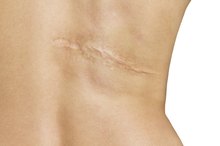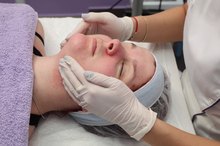Tazorac for Wrinkles
Over time, collagen and elastin fibers in the skin break down. These fibers are responsible for giving your skin structure and the lack of these fibers leads to wrinkling. Topical treatments, such as tazorac are used to reduce the appearance of fine wrinkling. Tazorac is an application similar to vitamin A that is used to treat skin conditions such as acne, psoriasis and wrinkles 3.
Function
Tazorac comes in two different formulation strengths, according to the 10 Acne website 3. These include .05 and .1 percent. When applied to the skin, Tazorac seeps into the pores and its ingredients become active. Tazorac acts similar to retinoid treatments when fighting wrinkles, meaning it penetrates the skin and encourages collagen production, giving the skin improved structure and reducing the appearance of fine lines, according to Dr. Audrey Kunin, a dermatologist writing on DERMA Doctor. Tazorac also encourages skin exfoliation, which can reduce the amount of dead skin cells on the face, giving you a more rejuvenated appearance.
- Tazorac comes in two different formulation strengths, according to the 10 Acne website 3.
- Tazorac acts similar to retinoid treatments when fighting wrinkles, meaning it penetrates the skin and encourages collagen production, giving the skin improved structure and reducing the appearance of fine lines, according to Dr. Audrey Kunin, a dermatologist writing on DERMA Doctor.
Application
Tretinoin Cream for Wrinkles
Learn More
Tazorac should be applied once per day, most typically at night, according to Drugs.com 1. Cleanse the face with a gentle cleanser—a more harsh cleanser can aggravate the skin when combined with Tazorac—and dry thoroughly. Massage Tazorac into your skin, applying a thin film to wrinkled areas. Do not apply to any areas that have open wounds or areas of irritation. Allow Tazorac to be fully absorbed before applying a moisturizer, which can reduce the potentially irritating effects of Tazorac.
- Tazorac should be applied once per day, most typically at night, according to Drugs.com 1.
- Allow Tazorac to be fully absorbed before applying a moisturizer, which can reduce the potentially irritating effects of Tazorac.
Benefits
Tazorac has been shown to be just as effective as its retinoid counterparts in treating fine wrinkles, according to Smart Skincare 2. Other beneficial effects include reduction of skin oiliness, blackheads, acne and psoriasis, according to Kunin.
Side Effects
Microdermabrasion vs. Glycolic Peel
Learn More
Tazorac is not associated with serious side effects, but you may experience irritation, tingling, redness or itching, according to Drugs.com 1. This often occurs as you initiate treatment and will likely subside with time. If you continue to experience side effects such as skin peeling or irritation after several weeks of application, reduce the amount applied or speak to your doctor for treatment alternatives. If you do experience itching, hives or swelling associated with an allergic reaction, seek emergency medical attention.
- Tazorac is not associated with serious side effects, but you may experience irritation, tingling, redness or itching, according to Drugs.com 1.
- If you continue to experience side effects such as skin peeling or irritation after several weeks of application, reduce the amount applied or speak to your doctor for treatment alternatives.
Warning
You should not apply tazorac if you are pregnant or could potentially be pregnant, according to Drugs.com 1. This is because tazorac could have harmful effects to an unknown fetus. If you are frequently exposed to sunlight, tazorac can result in adverse effects. You can remedy this through wearing sunscreen and protective clothing, such as a wide-brimmed hat.
- You should not apply tazorac if you are pregnant or could potentially be pregnant, according to Drugs.com 1.
- If you are frequently exposed to sunlight, tazorac can result in adverse effects.
Related Articles
References
- Drugs.com: Tazorac Medical Facts
- Smart Skincare: Retinoids in Skin Care
- 10 Acne: Tazorac Reviews
- DERMA Doctor: Retin A & Vitamin A Creams
- Khalil S, Bardawil T, Stephan C, et al. Retinoids: a journey from the molecular structures and mechanisms of action to clinical uses in dermatology and adverse effects. J Dermatolog Treat. 2017;28(8):684-696. doi:10.1080/09546634.2017.1309349
- Heath MS, Sahni DR, Curry ZA, Feldman SR. Pharmacokinetics of tazarotene and acitretin in psoriasis. Expert Opin Drug Metab Toxicol. 2018;14(9):919-927. doi:10.1080/17425255.2018.1515198
- Kim WB, Jerome D, Yeung J. Diagnosis and management of psoriasis. Can Fam Physician. 2017;63(4):278-285.
- Torsekar R, Gautam MM. Topical Therapies in Psoriasis. Indian Dermatol Online J. 2017;8(4):235-245. doi:10.4103/2229-5178.209622
- PDR. Tazarotene Drug Summary. 2020.
- Sarkar, R., Chugh, S. Garg, V. Acitretin in dermatology. Indian Journal of Dermatology, Venereology, and Leprology, 2013;79(6), 759. doi:10.4103/0378-6323.120721
- PDR. Soriatane. 2020.
- FDA. Soriatane (acitretin) capsules. 2020.
- Mehta, B. and Amladi, S. Evaluation of topical 0/1% tazarotene cream in the treatment of palmoplantar psoriasis: An observer-blinded randomized controlled study. Indian J Dermatol. 2011 Jan-Feb;56(1):40–43. doi:10.4103/0019-5154.77550
- U.S. Food and Drug Administration. Highlights of Prescribing Information: Tazorac (tazarotene) gel, 0.05% and 0.1%, for topical use. Silver Spring, Maryland; revised April 2018.
Writer Bio
Rachel Nall began writing in 2003. She is a former managing editor for custom health publications, including physician journals. She has written for The Associated Press and "Jezebel," "Charleston," "Chatter" and "Reach" magazines. Nall is currently pursuing her Bachelor of Science in Nursing at the University of Tennessee.









